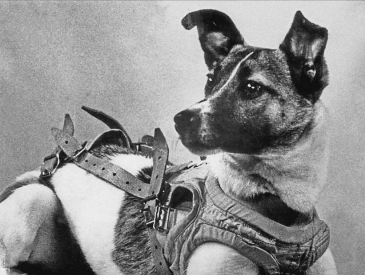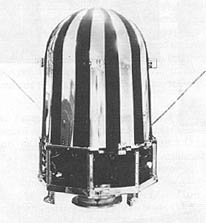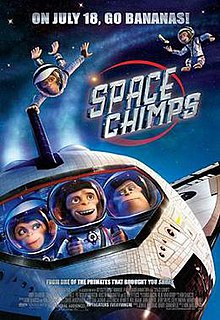 W
WAnimals in space originally served to test the survivability of spaceflight, before human spaceflights were attempted. Later, other non-human animals were flown to investigate various biological processes and the effects microgravity and space flight might have on them. Bioastronautics is an area of bioengineering research which spans the study and support of life in space. To date, seven national space programs have flown animals into space: the Soviet Union, United States, France, Argentina, China, Japan and Iran.
 W
WMiss Baker was a squirrel monkey who in 1959 became, along with female rhesus macaque Able, one of the first two animals launched into space by the United States who safely returned.
 W
WThe Bion satellites, also named Biocosmos, is a series of Soviet biosatellites focused on space medicine. They are part of the Kosmos satellites.
 W
WA biosatellite is an artificial satellite designed to carry plants or animals in outer space. They are used to research the effects of space on biological matter while in orbit around a celestial body. The first satellite carrying an animal was Soviet Sputnik 2 on November 3, 1957. On August 20, 1960 Soviet Sputnik 5 launched and recovered dogs from Earth orbit.
 W
WNASA launched three satellites named Biosatellite 1, 2 and 3 between 1966 and 1969.
 W
WEnos was the second chimpanzee launched into space by NASA. He was the first and only chimpanzee, and third hominid after cosmonauts Yuri Gagarin and Gherman Titov, to achieve Earth orbit. Enos's flight occurred on November 29, 1961.
 W
WFe, Fi, Fo, Fum, and Phooey were five mice who traveled to the Moon and circled it 75 times on the 1972 Apollo 17 mission. NASA gave them identification numbers A3305, A3326, A3352, A3356, and A3400, and their nicknames were given by the Apollo 17 crew, Eugene Cernan, Harrison Schmitt, and Ronald Evans. The four male mice, one female mouse, and Evans orbited the Moon for six days and four hours in the Apollo command module America as Cernan and Schmitt performed the Apollo program's last lunar excursions. One of the male mice died (A-3352) during the trip, and the four survivors were killed and dissected for their intended biological information upon their return from the Moon.
 W
WFélicette was a stray Parisian cat who was the only cat successfully launched into space. She was launched on 18 October 1963 as part of the French space program. Félicette was one of 14 female cats trained for spaceflight. The cats had electrodes implanted onto their skulls so their neurological activity could be monitored throughout the flight. Electrical impulses were applied to the brain and a leg during the flight to stimulate responses. The capsule was recovered 13 minutes after the rocket was ignited. Most of the data from the mission was of good quality, and Félicette survived the flight. A second feline was killed in a launch mishap on 24 October 1963.
 W
WGordo was one of the first monkeys to travel into space. As part of the NASA space program, Gordo, also known as Old Reliable, was launched from Cape Canaveral on December 13, 1958, in the U.S. PGM-19 Jupiter rocket on its AM-13 mission. The rocket would travel over 1,500 miles and reach a height of 310 miles (500 km) before returning to Earth and landing in the South Atlantic. A technical malfunction prevented the capsule's parachute from opening and, despite a short search, neither his body nor the vessel were ever recovered.
 W
WHam, also known as Ham the Chimp and Ham the Astrochimp, was a chimpanzee and the first great ape launched into space. On January 31, 1961, Ham flew a suborbital flight on the Mercury-Redstone 2 mission, part of the U.S. space program's Project Mercury.
 W
WLaika was a Soviet space dog who became one of the first animals in space, and the first animal to orbit the Earth. Laika, a stray mongrel from the streets of Moscow, was selected to be the occupant of the Soviet spacecraft Sputnik 2 that was launched into low orbit on 3 November 1957. No capacity for her recovery and survival was planned, and she died of overheating or asphyxiation shortly before she was to be poisoned.
 W
WBefore humans went into space in the 1960s, several other animals were launched into space, including numerous other primates, so that scientists could investigate the biological effects of spaceflight. The United States launched flights containing primate passengers primarily between 1948 and 1961 with one flight in 1969 and one in 1985. France launched two monkey-carrying flights in 1967. The Soviet Union and Russia launched monkeys between 1983 and 1996. Most primates were anesthetized before lift-off.
 W
WMoon Pilot is a 1962 American Technicolor science fiction comedy film from Walt Disney Productions, released through Buena Vista Distribution, directed by James Neilson, and starring Tom Tryon, Brian Keith, Edmond O'Brien, Dany Saval, and Tommy Kirk. The film is based on Robert Buckner's 1960 novel Starfire, and reflects Disney's interest in America's space program during John F. Kennedy's presidential era in the early 1960s.
 W
WOne Small Step: The Story of the Space Chimps is a 2008 documentary film produced and directed by David Cassidy and Kristin Davy which aired on History Channel UK and CBC Television. The film chronicles the real story behind the early use of chimpanzees in space exploration. The film was released on DVD in April 2008, after several delays. Cassidy is best known for co-producing the 2006 documentary Shut Up and Sing on the Dixie Chicks.
 W
WThe Orbiting Frog Otolith (OFO) was a NASA space program which sent two bullfrogs into orbit on 9 November 1970 for the study of weightlessness. The name, derived through common use, was a functional description of the biological experiment carried by the satellite. Otolith referred to the frog's inner ear balance mechanism.
 W
WRace to Space is a 2001 fictional American family drama film. The film was shot on location at Cape Canaveral and Cocoa Beach and Edwards AFB in cooperation with NASA and the U.S. Air Force.
 W
WNASA's Rodent Research Hardware System provides a research platform aboard the International Space Station for long-duration experiments on rodents in space. Such experiments will examine how microgravity affects the rodents, providing information relevant to human spaceflight, discoveries in basic biology, and knowledge that can help treat human disease on Earth.
 W
WDuring the 1950s and 1960s the Soviet space program used dogs for sub-orbital and orbital space flights to determine whether human spaceflight was feasible. In this period, the Soviet Union launched missions with passenger slots for at least 57 dogs. The number of dogs in space is smaller, as some dogs flew more than once. Most survived; the few that died were lost mostly through technical failures, according to the parameters of the test.
 W
WSpace Chimps is a 2008 computer-animated comic science fiction film directed by Kirk DeMicco in his directional debut, and written by DeMicco and Rob Moreland. It features the voices of Andy Samberg, Cheryl Hines, Jeff Daniels, Patrick Warburton, Kristin Chenoweth, Kenan Thompson, Zack Shada, Carlos Alazraqui, Omid Abtahi, Patrick Breen, Jane Lynch, Kath Soucie, and Stanley Tucci.
 W
WZond 5 was a spacecraft of the Soviet Zond program. In September 1968 it became the second spaceship to travel to and circle the Moon, and the first to return safely to Earth. Zond 5 carried the first terrestrial organisms to the vicinity of the Moon, including two tortoises, fruit fly eggs, and plants. The tortoises underwent biological changes during the flight, but it was concluded that the changes were primarily due to starvation and that they were little affected by space travel.
 W
WZond 6 was a formal member of the Soviet Zond program, and an unmanned version of the Soyuz 7K-L1 manned Moon-flyby spacecraft. It was launched on a lunar flyby mission from a parent satellite (68-101B) in Earth parking orbit. The spacecraft carried scientific probes including cosmic ray and micrometeoroid detectors, as well as photographic equipment and a biological payload of flies, bacteria and turtles. The mission was a precursor to a manned circumlunar flight which the Soviets hoped could occur in December 1968, thus beating the American Apollo 8. However, after rounding the Moon, Zond 6 crashed on its return to Earth, due to a parachute failure.